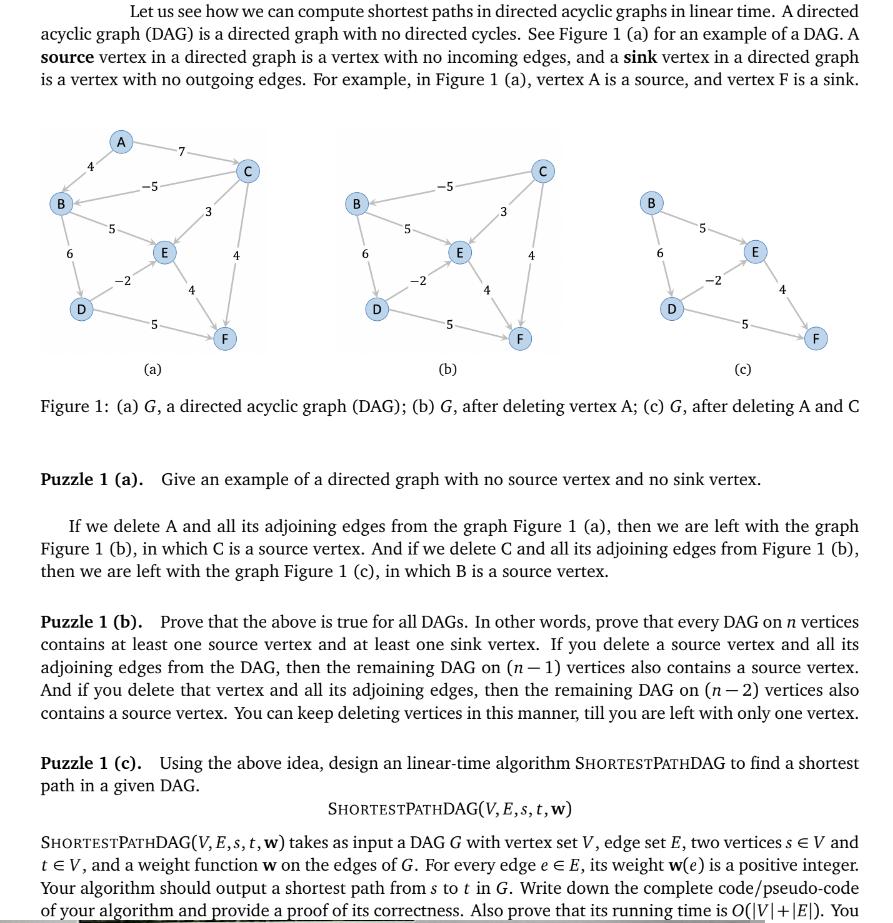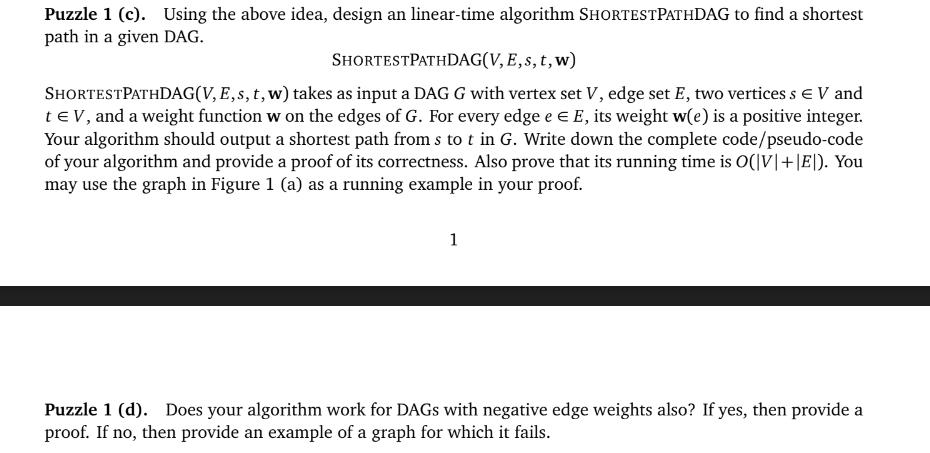Answered step by step
Verified Expert Solution
Question
1 Approved Answer
Let us see how we can compute shortest paths in directed acyclic graphs in linear time. A directed acyclic graph (DAG) is a directed


Let us see how we can compute shortest paths in directed acyclic graphs in linear time. A directed acyclic graph (DAG) is a directed graph with no directed cycles. See Figure 1 (a) for an example of a DAG. A source vertex in a directed graph is a vertex with no incoming edges, and a sink vertex in a directed graph is a vertex with no outgoing edges. For example, in Figure 1 (a), vertex A is a source, and vertex F is a sink. B 6 O 5 A N " 12 E 7 3 F 4 B 6 D -5 5 E 3 F 4 C B 6 D 10 -2 5 E F (a) (b) (c) Figure 1: (a) G, a directed acyclic graph (DAG); (b) G, after deleting vertex A; (c) G, after deleting A and C Puzzle 1 (a). Give an example of a directed graph with no source vertex and no sink vertex. If we delete A and all its adjoining edges from the graph Figure 1 (a), then we are left with the graph Figure 1 (b), in which C is a source vertex. And if we delete C and all its adjoining edges from Figure 1 (b), then we are left with the graph Figure 1 (c), in which B is a source vertex. Puzzle 1 (b). Prove that the above is true for all DAGS. In other words, prove that every DAG on n vertices contains at least one source vertex and at least one sink vertex. If you delete a source vertex and all its adjoining edges from the DAG, then the remaining DAG on (n-1) vertices also contains a source vertex. And if you delete that vertex and all its adjoining edges, then the remaining DAG on (n-2) vertices also contains a source vertex. You can keep deleting vertices in this manner, till you are left with only one vertex. Puzzle 1 (c). Using the above idea, design an linear-time algorithm SHORTESTPATHDAG to find a shortest path in a given DAG. SHORTESTPATHDAG(V, E, s, t, w) SHORTESTPATHDAG(V, E, s, t, w) takes as input a DAG G with vertex set V, edge set E, two vertices s V and te V, and a weight function w on the edges of G. For every edge e E, its weight w(e) is a positive integer. Your algorithm should output a shortest path from s to t in G. Write down the complete code/pseudo-code of your algorithm and provide a proof of its correctness. Also prove that its running time is O(IV+E). You Puzzle 1 (c). Using the above idea, design an linear-time algorithm SHORTESTPATHDAG to find a shortest path in a given DAG. SHORTESTPATHDAG(V, E, s, t, w) SHORTESTPATHDAG(V, E, s, t, w) takes as input a DAG G with vertex set V, edge set E, two vertices s V and t EV, and a weight function w on the edges of G. For every edge e E, its weight w(e) is a positive integer. Your algorithm should output a shortest path from s to t in G. Write down the complete code/pseudo-code of your algorithm and provide a proof of its correctness. Also prove that its running time is O(IV+ |E|). You may use the graph in Figure 1 (a) as a running example in your proof. 1 Puzzle 1 (d). Does your algorithm work for DAGS with negative edge weights also? If yes, then provide a proof. If no, then provide an example of a graph for which it fails.
Step by Step Solution
There are 3 Steps involved in it
Step: 1
Puzzle 1 a Directed Graph with No Source or Sink Vertex Example of a directed acyclic graph DAG with no source vertex and no sink vertex Explanation In this graph there is no vertex with incoming edges only source vertex and no vertex with outgoing edges only sink vertex Puzzle 1 b Proving the Existence of Source and Sink Vertices in DAGs We will prove that in any DAG with n vertices there must always exist at least one source vertex and at least one sink vertex Additionally when you repeatedly delete source vertices and their edges you will always end up with a graph that contains a source vertex until you are left with a single vertex Proof 1Base Case n 1 For a DAG with only one vertex it trivially contains a source vertex and a sink vertex the same vertex 2Inductive Hypothesis Assume that for any DAG with k vertices where k 1 there exists at least one source vertex and at least one sink vertex Furthermore after deleting a source vertex and its edges repeatedly the resulting graph on k 1 vertices will contain a source vertex 3Inductive Step Now consider a DAG with k 1 vertices a Case 1 There exists a vertex with no incoming edges If there is a vertex A with no incoming edges then A is a source vertex because no other vertex contributes edges to it In this case we have found a source vertex b Case 2 There is no vertex with no incoming edges In this case all vertices must have at least one incoming edge ...
Get Instant Access to Expert-Tailored Solutions
See step-by-step solutions with expert insights and AI powered tools for academic success
Step: 2

Step: 3

Ace Your Homework with AI
Get the answers you need in no time with our AI-driven, step-by-step assistance
Get Started


